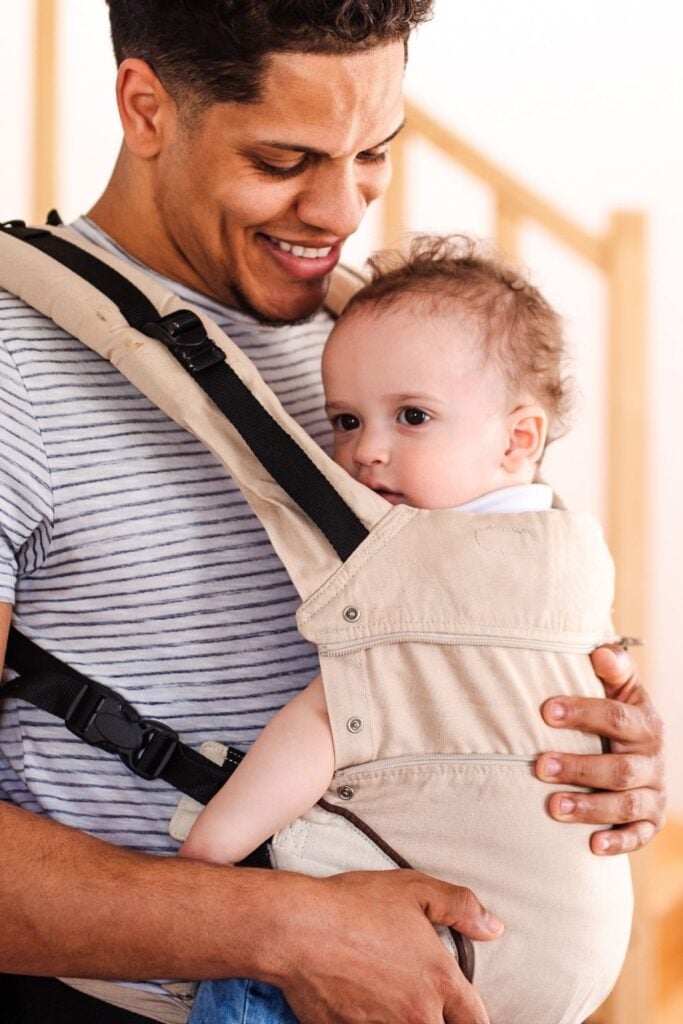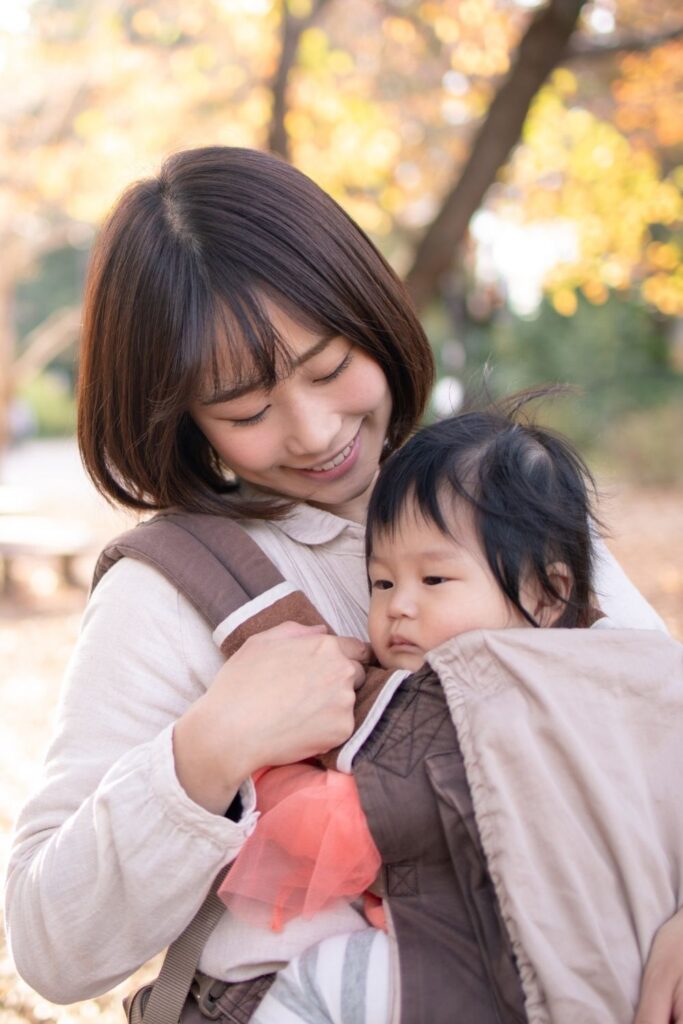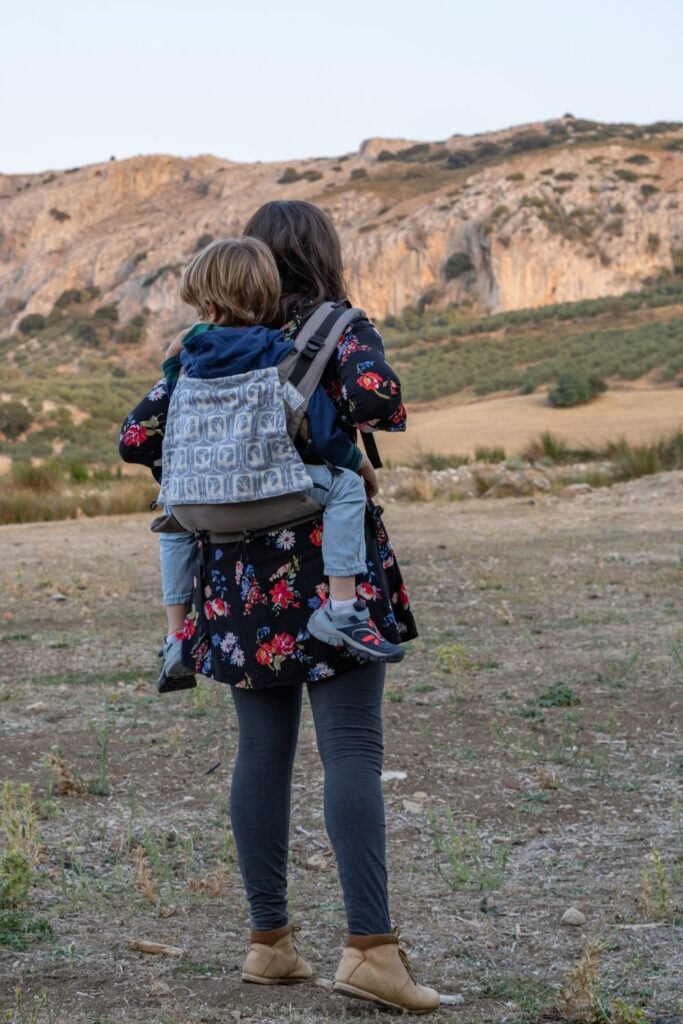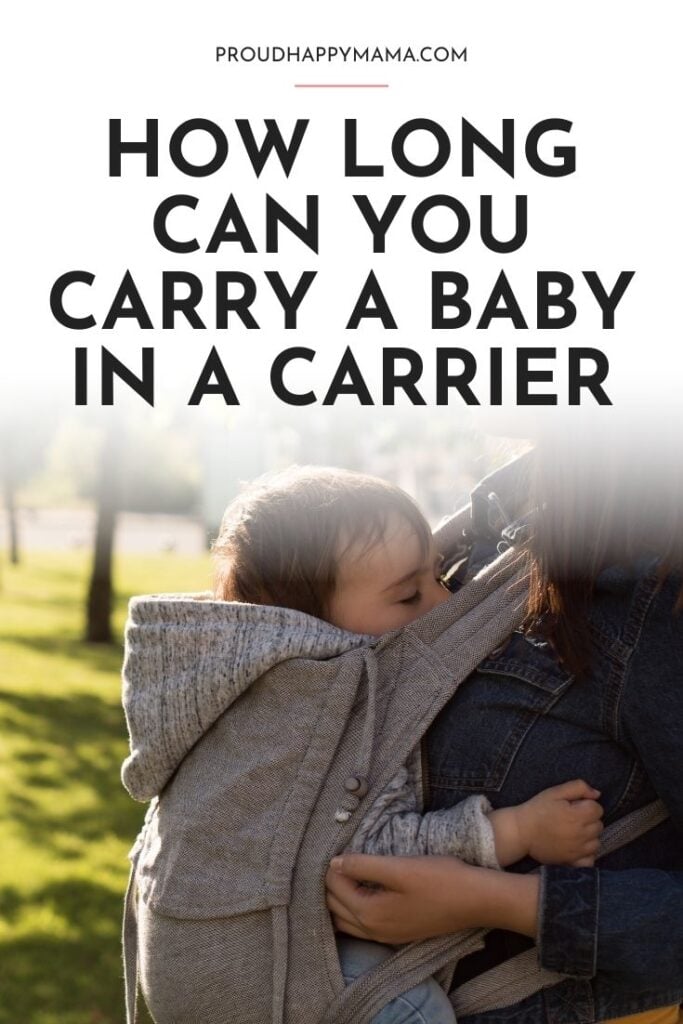How Long Can You Carry a Baby in a Carrier?
Have you been wondering how long you can carry a baby in a carrier?
Well, let us help put your mind at ease as we walk you through how long can I carry my baby in a carrier.
Babywearing is a big part of attachment parenting that helps to foster a parents bond with their baby, whist also freeing up your hands so you can get things done. You’ll feel close to your baby, and your baby loves the closeness as you head to the store or fold laundry, but you might wonder how long do you use a baby carrier for.
Experts have not set an official time limit for wearing your baby in a carrier. However, parents need to understand the safety and developmental risks of using a carrier for long periods. It does come with some dangers, such as suffocation, positional asphyxiation, overheating, hip dysplasia, and more.
But the good news is you can eliminate all of these risks by understanding proper and safe babywearing guidelines. The amount of time your baby stays in a carrier should always be limited, and your baby needs to be monitored closely while in a carrier.
Let’s look at what you need to know about how long babies can be in a carrier.
And if you love this guide on babywearing time limits, make sure to check our these guides on when can your baby face forward in carrier, baby carriers vs wraps, and best baby carriers for bad backs! Or these best carriers for toddlers!

How Long Can You Carry a Baby in a Carrier?
There is no set maximum time to carry your baby in a carrier. Typically, the amount of time you’ll wear your baby depends on the style of carrier, your baby’s age, and weight.
A general rule is that you shouldn’t wear your baby for longer than two hours at a time, but that depends heavily on several factors. If you wear your baby for three hours, nothing detrimental will happen to either of you as long as your baby is in the proper position and you feel comfortable.
How to Keep Your Baby Safe in a Carrier
Since there are no hard-fast rules about the time limits and babywearing, parents must keep safety at the forefront of their minds. Here are some factors parents need to consider when wearing their baby for long periods.
1. Protect Your Baby’s Airway
One of the most important safety features is to make sure the fabric doesn’t cover your baby’s face, or your baby might not be able to breathe, leading to suffocation.
This is known as positional asphyxiation that occurs when babies suffocate from being in a position that restricts their breathing. When carrying your baby in a carrier for long periods, make sure they aren’t slumped over, especially when in a forward-facing position, and always check their breathing.
One of the most dangerous positions when babywearing is the slumped posture because the rib cage cannot expand properly. When a baby is slumped over, their diaphragm cannot work correctly, making breathing even harder. In addition, the trachea can close when a baby’s head hangs forward.
Here’s how to make sure you reduce the risk of suffocation and positional asphyxiation.
- Keep your baby’s face visible, ensuring his face is not obstructed.
- Take breaks and check on your baby regularly.
- Ensure your baby is in the correct position.
- Keep the carrier strapped and appropriately tightened to avoid slouching.
2. Think about The Weather
When you’re babywearing in the summer or hot weather, parents have to be aware of the temperature because it increases the risk of overheating.
It starts with ensuring you use a carrier best for hot weather and make sure you take your baby out of the carrier regularly when it’s hot outside while babywearing. Stay in cool, shady areas, and try to keep your baby cool with spray bottles or cool washcloths.
We recommend checking our out these best baby carriers for hot weather if you plan to babywear in warmer temperatures.
3. Adjust Regularly
When you’re wearing your baby for long periods, adjusting them regularly helps keep everyone comfortable and safe. Change the side your baby’s head is resting on you to reduce the risk of muscle stress.
Take your baby out of the carrier, stretch his body and let him lay flat for some time.

4. Hip Healthy Matters
When you buy a baby carrier, ensure that it’s a hip-healthy carrier that will keep your baby in the correct hip-healthy position. We know that holding an infant’s leg together for long periods increases the risk of hip dysplasia, leading to hip dislocations.
We see this problem with babies who are swaddled too tightly with their legs straight out. So, the healthiest way to carry your baby is the natural position of being spread apart to either side with their thighs supported and hips and knees bent – called the “M” position.
5. Take Breaks!
It’s easy for babies to spend too much time in “containers,” such as car seats, rockers, swings, carriers, etc. Spending too much time in containers reduces the amount of time for your baby to move freely, reducing his overall strength and coordination.
When Can You Start Using a Baby Carrier?
It’s possible to start using a carrier as soon as your baby is born; babies are used to being cozy and snuggly when in the womb. A carrier makes sense! Many cultures use a wrap or a sling as soon as babies emerge.
However, parents need to make sure their carrier works for newborns if they want to start using a carrier immediately. Newborn babies need head and neck support to be age-appropriate. Some soft structured carriers have an infant insert to make them work for newborns.

How Long Can You Carry a Baby in a Soft Structured Carrier
A soft structured carrier is sort of like a backpack for babies, and it’s one of the most common carriers choices for parents. These carriers have padded waistbands and padded shoulder straps to give parents plenty of structure and comfort while babywearing.
Many SSCs are suitable for newborns, but some aren’t, so you need to make sure you pay attention. You might have to buy a separate insert to make it adaptable for your little infant.
However, many soft structured carriers have a seat width adjustment that grows with your baby, starting as low as 7lbs.
As long as your baby is in a correct, safe, ergonomic position, you can carry your child, no matter the age, for as long as you want in an SSC. Since these carriers offer a lot of support for parents, this is the easiest carrier to use for older infants and toddlers for extended periods.
How Long Can You Carry a Baby in a Baby Wrap?
Wraps are a basic type of baby carrier: a long piece of fabric made from cotton or linen. Sometimes, they are made with a stretchy fabric, especially if you have a newborn. These are ideal for young infants, and they can be wrapped in many different ways, and they offer head support.
When it comes to small infants, babies need to eat every two to three hours so that they might stay in a carrier comfortably between feedings. Generally, as long as your baby is comfortable and happy, it’s safe to keep them in a carrier.
However, when it comes to older infants and toddlers, you won’t want to carry your child around for long periods. Not only do toddlers get antsy, but their weight will pull on your back and shoulders. So it’s safe to wear a toddler for as long as they’re happy and you’re happy!
How Long Can You Carry a Baby in a Baby Ring Sling
A ring sling is a long piece of fabric that has two rings that you wear over one shoulder, creating a sort of pouch for your baby to sit. These are popular for parents, especially during the summer, because they are lightweight and only hang over one side of your body.
It’s safe to use slings starting as soon as your baby is born until around three years old, but as your child gets older, you’ll have more strain on your shoulder.
Since a ring sling keeps your baby in an ergonomic position that is snug and cozy, your newborn will be content to sleep for hours. You might find that you only need to take your baby out for changes and feedings.
However, as your child gets older, their weight increases, so a sling tends to provide less support for the parent. Your toddler will feel content, but chances are you will feel a strain on your shoulder.
Final Thoughts on How Long Can I Carry My Baby in a Carrier
The truth is that there is no set time limit for how long you can carry a baby in a carrier. Watch your baby for signs of problems and take breaks regularly. In general, it’s safe to keep your baby in a carrier for two hours or more, as long as both of you are comfortable and happy.
And if you’re looking for more great baby guides, then check out these guides on best baby carriers for breastfeeding, Baby Bjorn vs Ergo Baby Carrier, and best plus size baby carriers.


